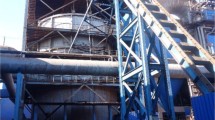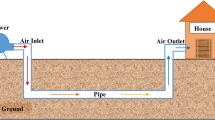Abstract
This study discuss the application of Taguchi method in assessing maximum cooling tower effectiveness for the counter flow cooling tower using different types of packing. The experiments were planned based on Taguchi’s L9 orthogonal array. The trial was performed under different conditions of liquid-to-gas flow ratio, inlet water temperature and packing materials. Signal-to-noise ratio analysis, analysis of variance and regression were carried out in order to determine the effects of process parameters on cooling tower effectiveness and to identify optimal factor settings. Finally, confirmation tests verified the reliability of Taguchi method for optimization of counter flow cooling tower performance with sufficient accuracy.







Similar content being viewed by others
Abbreviations
- A:
-
Approach
- AF:
-
Air flow (kg/h)
- DOF:
-
Degree of freedom
- R:
-
Range
- S/N:
-
Signal-to-noise ratio
- T:
-
Temperature (°C)
- WF:
-
Water flow (kg/h)
- WT:
-
Water temperature (°C)
- Ε:
-
Cooling tower effectiveness
- i:
-
Inlet
- o:
-
Outlet
- w:
-
Water
- wb:
-
Wet bulb
- EWM:
-
Expanded wire mesh
- GI:
-
Galvanised iron
- PVC:
-
Polyvinyl chloride
References
Walker WH, Lewis WK, McAdams WH, Gilliland ER (1923) Principle of chemical engineering, 3rd edn. McGraw-Hill Inc, New York
Simpson WM, Sherwood TK (1946) Performance of small mechanical draft cooling towers. Am Soc Refrig Eng 52:535–543, and 574–576
Kelly NW, Swenson LK (1956) Comparative performance of cooling tower packing arrangements. Chem Eng Prog 52:263–268
Barile RG, Dengler JL, Hertwig TA (1974) Performance and design of a turbulent bed cooling tower. AIChE Symp Ser 70:154–162
Bedekar SV, Nithiarasu P, Seethatamu KN (1998) Experimental investigation of the performance of a counter flow packed bed mechanical cooling tower. Energy 23:943–947
Goshayshi HR, Missenden JF (2000) The investigation of cooling tower packing in various arrangements. Appl Therm Eng 20:69–80
Kloppers JC, Kroger DG (2003) Loss coefficient correlation for wet cooling tower fills. Appl Therm Eng 23:2201–2211
Lemouari M (2001) Experimental study of the air/water heat transfer by direct contact in a column packed with vertical grids- application to the water cooling, MSc. thesis, University of Bejaia, Algeria
Lemouari M, Boumaza M (2003) Experimental study of the air/water heat transfer by direct contact in a column packed with vertical grids—application to the water cooling. In: Proceeding 11th international meeting on heat transfer, vol. 2, pp 457–464
Lemouari M, Boumaza M (2005) An experimental investigation of thermal characteristics of a mechanical draft wet cooling tower. In: Proceedings 13th IAHR, Poitiers, France
Lemouari M, Boumaza M, Mujtaba IM (2007) Thermal performance investigation of a wet cooling tower. Appl Therm Eng 27:902–909
Lemouari M, Boumaza M (2010) Experimental investigation of the performance characteristics of a counterflow wet cooling tower. Int J Therm Sci 49:2049–2056
Taguchi G, Elsayed EA, Hsiang T (1989) Quality engineering in production system. McGraw-Hill, New York
Taguchi G (1981) On-Line quality control during production. Japan Standard association, Tokyo
Vijayan S, Raju R, Subbaiah K, Sridhar N, Rao SRK (2009) Friction stirs welding of Al-MG alloy optimization of process parameters using Taguchi method. Exp Tech 34(5):37–44
Yang WH, Tang YS (1988) Design optimization of cutting parameters for turning operations based on the Taguchi method. J Mater Process Technol 84(1–3):122–129
Bagci E, Aykut S (2006) A study of Taguchi optimization method for identifying optimum surface roughness in CNC face milling of cobalt-based alloy (satellite 6). Int J Adv Manuf Technol 29:940–947
Hasan C, Tuncay E, Ibrahim U (2007) Application of Taguchi optimization technique in determining plastic injection molding process parameters for a thin-shell part. Mater Des 28:1271–1278
Phadke MS (1989) Quality engineering using robust design. Prentice-Hall, Englewood Cliffs, NJ, pp 41–65
Avanish KD, Vinod Y (2007) Simultaneous optimization of multiple quality characteristics in laser beam cutting using Taguchi method. Int J Precis Eng Manuf 8(4):10–15
Acknowledgments
The authors wish to thank the authorities of Annamalai University, Annamalai Nagar, Tamil Nadu, India, for the facilities provided to conduct the experiment in the steam laboratory for the research work.
Author information
Authors and Affiliations
Corresponding author
Additional information
Technical Editor: Fernando Alves Rochinha.
Rights and permissions
About this article
Cite this article
Ramkumar, R., Ragupathy, A. Optimization of cooling tower performance with different types of packings using Taguchi approach. J Braz. Soc. Mech. Sci. Eng. 37, 929–936 (2015). https://doi.org/10.1007/s40430-014-0216-1
Received:
Accepted:
Published:
Issue Date:
DOI: https://doi.org/10.1007/s40430-014-0216-1




